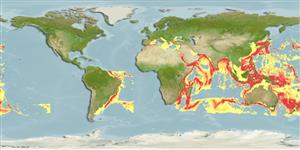Common names from other countries
Environment: milieu / climate zone / depth range / distribution range
Ecologie
; brakwater; diepteverspreiding 0 - 4177 m (Ref. 107353). Tropical
Circumglobal.
Length at first maturity / Size / Gewicht / Leeftijd
Maturity: Lm ? range ? - ? cm Max length : 3.0 cm WD mannelijk/geslacht niet bekend; (Ref. 7493)
Intertidal (Ref. 81522); Littoral to sublittoral fringe areas; known as a fouling species (Ref. 81749) - on piers, pontoons, and boat hulls (Ref. 102838). In sheltered (Ref. 125338) to exposed rocky shores. Can be found on the shells of predatory gastropods Reishia clavigera and Cellana toreuma (Ref. 127116). Part of both epibenthic and arboreal communities in mangrove areas (Ref. 128397). Sessile suspension feeder (Ref. 125928).
Life cycle and mating behavior
Geslachtsrijpheid | Voortplanting | Kuitschieten | Eieren | Fecundity | Larven
Members of the superorder Thoracica are mostly hermaphroditic. Broadcast spawners, fertilization occurs in the mantle cavity. Life cycle: Eggs hatch into planktonic nauplii and leave the mantle cavity. Afterwards, they undergo six naupliar instars succeded by nonfeeding cypris larva (settling stage) which later metamorphose into adults.
Paulay, G. and A. Ross. 2003. (Ref. 7493)
Status op de Rode Lijst van het IUCN (Ref. 130435)
Status bij CITES (Ref. 108899)
Not Evaluated
Not Evaluated
Gebruik door de mens
| FishSource |
Tools
Internet-bronnen
Estimates based on models
Preferred temperature
(Ref.
115969): 2.8 - 13.7, mean 4.5 (based on 1972 cells).
Weerstandsvermogen
Hoog, minimale populatieverdubbelingstijd minder dan 15 maanden (K=0.44-0.47).
Kwetsbaarheid
Low vulnerability (10 of 100).
Prijsklasse
Unknown.
